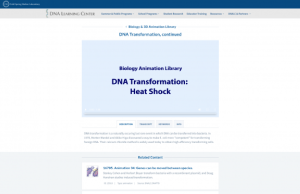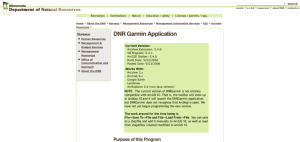Browse Resources
Resources | |
|---|---|
This animation from Cold Spring Harbor Laboratory's Dolan DNA Learning Center presents DNA arrays. The animation contains information on Pat Brown's discovery and the purpose of DNA arrays to study gene expression as well as its role in the development of pharmacogenomic treatment for diseases such...
This virtual lab from the Genetic Science Learning Center at the University of Utah provides an overview of DNA extraction, including what it's used for, illustrations, and an activity using cheek cells and laboratory equipment to isolate DNA. The lab is followed by a classroom activity that allows...
This animated video, created by Support Center for Microsystems Education (SCME), illustrates how DNA hybridization works in the context of nanofabrication. The animation and associated narration describe "DNA hybridization is when a single-stranded DNA (ssDNA) molecule bonds with a complementary...
This animated video, created by Support Center for Microsystems Education (SCME), illustrates how DNA microarrays work in the context of nanofabrication. The animation and associated narration describe "how a DNA microarray identifies complementary DNA (cDNA) strands from a sample. On the substrate...
In this video, created by Support Center for Microsystems Education (SCME), viewers are introduced to the concept of DNA microarray fabrication. Specific topics include: non-contact printing process, photolithography process and maskless photolithography process. This is the third in a series of...
The discovery of enzymes that could cut and paste DNA made genetic engineering possible. Restriction enzymes, found naturally in bacteria, can be used to cut DNA fragment at specific sequences, while another enzyme, DNA ligase, can attach or rejoin DNA fragments with complementary ends. This...
Stanley Cohen and Herbert Boyer's historic experiment used techniques to cut and paste DNA to create the first custom-made organism containing recombined or 'recombinant' DNA. Cohen and Boyer inserted the recombinant DNA molecule they created into E. coli bacteria by means of a plasmid, thereby...
DNA transformation is a naturally occurring but rare event in which DNA can be transferred into bacteria. In 1970, Morton Mandel and Akiko Higa discovered a way to make E. coli more 'competent' for transforming foreign DNA. Their calcium chloride method is widely used today to obtain high-efficiency...
This website from the Minnesota department of natural resources provides information on the Garmin DNR application. The purpose of the application, its functionality and screenshots are included. The site also includes links which may be used to download the program.
This 1-page document, from the Advanced Technology Environmental and Energy Center (ATEEC), summarizes a learning activity that helps students studying the concepts of biotic/abiotic factors and biodiversity. In the activity, students collect samples from outdoor areas, interpret data, and discover...
| |
| ← Previous | Next → |









